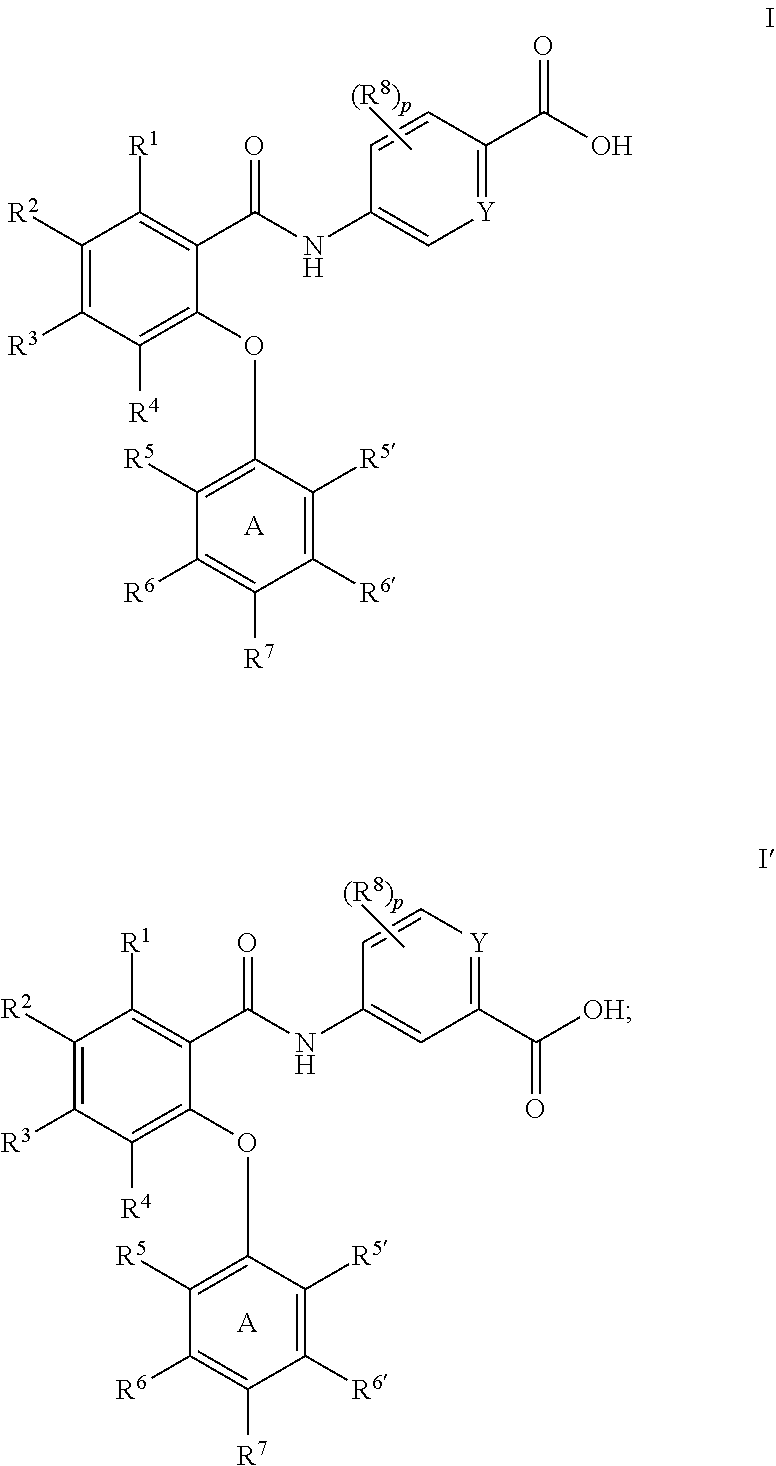Amides as modulators of sodium channels
a technology of sodium channel and modulator, which is applied in the direction of biocide, drug composition, peptide/protein ingredients, etc., can solve the problems of poor therapeutic window of v /sub>inhibitors
- Summary
- Abstract
- Description
- Claims
- Application Information
AI Technical Summary
Benefits of technology
Problems solved by technology
Method used
Image
Examples
example 1
Preparation of 5-(2-(2,4-dimethoxyphenoxy)-5-(trifluoromethyl)benzamido)picolinic acid (65)
[0577]
[0578]A solution of 2-fluoro-5-(trifluoromethyl)benzoyl chloride (2.98 mL, 19.72 mmol) in dichloromethane (22.3 mL) was added drop-wise to a mixture of methyl 5-aminopyridine-2-carboxylate (3.0 g, 19.72 mmol), pyridine (4.80 mL, 59.16 mmol) and dichloromethane (89.4 mL) at 0° C. The mixture was removed from the ice bath after 1.5 hours and was stirred at room temperature for 0.5 hours. The mixture was poured into 1N HCl (50 mL) and dichloromethane (50 mL). The layers were separated and the organic layer was dried over sodium sulfate, filtered and concentrated under reduced pressure. The product was slurried in hexanes to remove impurities. The solid was isolated by filtration rinsing with hexanes to yield methyl 5-[[2-fluoro-5-(trifluoromethyl)benzoyl]amino]pyridine-2-carboxylate (5.16 g, 76%) as an off-white solid. 1H NMR (400 MHz, DMSO-d6) δ 11.18 (s, 1H), 8.95 (d, J=2.5 Hz, 1H), 8.38 ...
example 2
Preparation of 5-(4,5-dichloro-2-(4-fluoro-2-methoxyphenoxy)benzamido)picolinic acid (51)
[0582]
[0583]A solution of 4,5-dichloro-2-fluoro-benzoyl chloride (4.35 g, 19.13 mmol) in dichloromethane (40 mL) was added drop-wise to a mixture of methyl 5-aminopyridine-2-carboxylate (2.91 g, 19.13 mmol), pyridine (4.64 mL, 57.39 mmol) and dichloromethane (60 mL) at 0° C. The reaction was stirred and allowed to warm up to room temperature over 2 hours. The mixture was poured into 1N HCl (50 mL) and dichloromethane (50 mL). The two layers were separated. The aqueous layer was extracted with dichloromethane (3×200 mL). The combined organic layer was washed with water (1×150 mL), dried over sodium sulfate, filtered and concentrated under reduced pressure. The product was slurried in hexanes to remove impurities. The solid was isolated by filtration using hexane to yield methyl 5-[(4,5-dichloro-2-fluoro-benzoyl)amino]pyridine-2-carboxylate (5.33 g, 81%) as a cream color solid. 1H NMR (400 MHz, DM...
example 3
Preparation of 5-(2-(2,4-dimethoxyphenoxy)-4,6-bis(trifluoromethyl)benzamido)picolinic acid (49)
[0586]
[0587]A solution of 2-fluoro-4,6-bis(trifluoromethyl)benzoyl chloride (1.0 g, 3.39 mmol) and dichloromethane (5.0 mL) was added drop-wise to a mixture of methyl 5-aminopyridine-2-carboxylate (619.9 mg, 4.07 mmol), pyridine (824.1 μL, 10.18 mmol) in dichloromethane (20.00 mL) at 0° C. The mixture was allowed to warm to room temperature and was stirred at that temperature overnight. The mixture was poured into 1N HCl and dichloromethane. The layers were separated and the organic layer was dried over sodium sulfate, filtered and concentrated under reduced pressure to give a tan solid. The product was purified on column chromatography eluting with 10-100% ethyl acetate in hexanes to obtain methyl 5-[[2-fluoro-4,6-bis(trifluoromethyl)benzoyl]amino]pyridine-2-carboxylate (850 mg, 61%) as a white solid. ESI-MS m / z calc. 410.05. found 411.0 (M+1)+; Retention time: 0.62 minutes (3 minutes ru...
PUM
| Property | Measurement | Unit |
|---|---|---|
| temperature | aaaaa | aaaaa |
| temperature | aaaaa | aaaaa |
| temperature | aaaaa | aaaaa |
Abstract
Description
Claims
Application Information
 Login to View More
Login to View More - R&D
- Intellectual Property
- Life Sciences
- Materials
- Tech Scout
- Unparalleled Data Quality
- Higher Quality Content
- 60% Fewer Hallucinations
Browse by: Latest US Patents, China's latest patents, Technical Efficacy Thesaurus, Application Domain, Technology Topic, Popular Technical Reports.
© 2025 PatSnap. All rights reserved.Legal|Privacy policy|Modern Slavery Act Transparency Statement|Sitemap|About US| Contact US: help@patsnap.com



